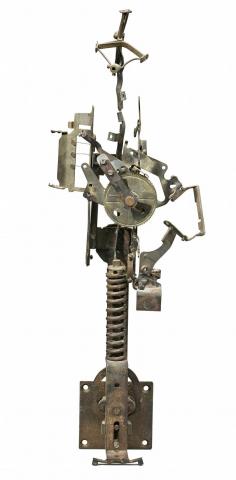NO. 183, 1965
Robert Klippel
metal construction
53.0 cm height
Gallery A, Sydney
The Estate of Neville Gruzman, Sydney
Gallery A, Sydney, 25 November 1965
Gleeson, J., Robert Klippel, Bay Books, Sydney, 1983, pl. 163, p. 269 (illus.)
Edwards, D., Robert Klippel: Catalogue raissoné of Sculpture, Art Gallery of New South Wales, Sydney, 2002, no. 183 (illus.)
Always a highly intuitive and original artist, Robert Klippel's unwavering dedication to his art has resulted in the production of some of the most innovative and original sculpture in Australia. As Roger Taylor observes, 'Klippel's aim had always been to constitute an art which reflected mankind's involvement in a 'scientific, machine, speedy age.' As with all his works, Klippel's metal sculptures took their lead from that celebration of the machine age which informed so much of avant-garde Modernist art in the early twentieth century. His totem-like forms eulogised machinery and mechanical parts in a winsome fusion of technology and art. It was that strange and unexpected combination of forms in Klippel's bronzes which gave them such verve. If each of these sculptures appears to be a series of mechanical parts somewhat randomly, albeit aesthetically pieced together, it is because the reorganisation of inanimate parts into a coercive and cohesive entity was at the core of Klippel's assemblage practice. These bronzes simply represent more innovative manifestations of the unchanging preoccupations within the artist's oeuvre.'1
Dating from that vintage year of 1965 during which Klippel created some of his finest achievements, No. 183 exemplifies brilliantly the metal constructions from this period which are typically columnar or tree-like, or both in subtle combination. A column with a tendency to branch, here one arm flutters away from the central shaft with an erratic movement suggesting an impetuous escape from confinement. Despite immediately discernible differences in medium, style and technique, indeed the work bears strong affinities with the artist's wooden sculptures of the late forties and early fifties which, thinly spread and sparing in their use of material, are characterised by a similar sense of openness or sparseness, as of a drawing in space. Accordingly, appreciation of No. 183 relies as much upon the negative volumes, the shapes of emptiness that burgeon on these slender armatures, as the actual metal forms of the sculpture itself. Elucidating the complexity inherent within these metal constructions, indeed Gleeson suggests '...they are, of all his works, the ones that make the greatest demands upon their viewers. They are so immediately engaging, so elegant, so visually seductive in their varying forms of grace, that there is a temptation to read only what is written in the metal and to forget that the material form is the matrix of a larger reality... They are what they are; they are also what they are not, in the sense that much of their true substance as sculpture is intangible and invisible except to those who make the effort to read them at the level at which intuition acts as an extension of eyesight.'2
1. Taylor, R., Robert Klippel 1920-2001, Australian Art Resources, Melbourne, 2001, p. 7
2. Gleeson, J., Robert Klippel, Bay Books, Sydney, 1983, p. 265
VERONICA ANGELATOS
